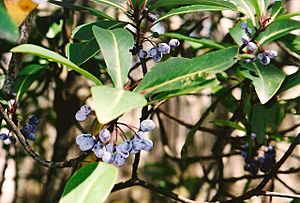Broad-leaved pepperbush facts for kids
Quick facts for kids Broad-leaved pepperbush |
|
|---|---|
 |
|
| Tasmannia purpurascens near Mount Barrington, Australia | |
| Scientific classification | |
| Genus: |
Tasmannia
|
| Species: |
purpurascens
|
| Synonyms | |
|
* Drimys purpurascens (Vickery) |
|
The Broad-leaved Pepperbush (Tasmannia purpurascens) is a special shrub. It's also called the Purple Pepperbush. This plant belongs to an old plant family called Winteraceae. You can only find it growing in two places in New South Wales, Australia: the Barrington Tops and Ben Halls Gap areas. It grows well in these specific mountain habitats. These places get a lot of rain. You often see it growing near Antarctic beech trees.
Contents
What Does Broad-leaved Pepperbush Look Like?
Tasmannia purpurascens is usually a shrub that grows about 1 to 3 meters (3 to 10 feet) tall. It has a woody stem. Its new leaves and small branches often have a purplish color.
Its leaves are shaped like an egg with a rounded tip. They are usually 8 to 18 centimeters (3 to 7 inches) long. The leaves are also 30 to 50 millimeters (1 to 2 inches) wide. They are smooth and have a purplish base. The main vein on the underside of the leaf sticks out.
Creamy-white flowers appear in November. They are about 25 millimeters (1 inch) wide. These flowers grow in clusters that look like umbrellas. Each plant has both male and female flowers. The flowers have two petals, each 8 to 12 millimeters (0.3 to 0.5 inches) long. Female flowers have a part called an ovary that is about 2 millimeters (0.08 inches) long.
Around Easter time, you can see fleshy, purplish-black berries. These berries are oval-shaped and about 10 to 15 millimeters (0.4 to 0.6 inches) long.
How Was This Plant Named?
The Broad-leaved Pepperbush was first officially described in 1937. A scientist named Joyce Vickery gave it the name Drimys purpurascens. She published her description in a science journal.
Later, in 1969, another scientist named Albert Smith moved the species to the Tasmannia group. He did this because of its chromosome number. The name purpurascens comes from Latin words. Purpureus means "purple," and -escens means "becoming." This refers to the reddish-purple color at the base of the leaf's main vein.
The Tasmannia group of plants is very interesting to scientists. This is because they are some of the most basic flowering plants on Earth. They have a very simple flower structure. Also, their wood is like that of conifers (like pine trees). It doesn't have special tubes called vessels that most other flowering plants have.
Like other plants in its group, it's sometimes called "pepperbush." This is because its fruits and seeds have a spicy taste. People have even used them to flavor food!
Where Does Broad-leaved Pepperbush Grow?
Tasmannia purpurascens grows in forests. It is found with Antarctic beech and eucalypt trees. It grows at high places, from 1200 to 1520 meters (3,900 to 5,000 feet) above sea level.
You can find many of these plants in the Ben Halls Gap and Barrington Tops National Parks. These areas often get snow and frost in winter.
Is Broad-leaved Pepperbush Protected?
Tasmannia purpurascens was once listed as "Vulnerable." This meant it was at risk of disappearing. However, it was removed from the national list in 2013. It is still listed as "vulnerable" in New South Wales. This means it still needs protection in that state.
Can You Grow Broad-leaved Pepperbush at Home?
It's hard to grow this plant from seeds. But it's easy to grow new plants from cuttings. Cuttings are small pieces of the plant taken in early autumn.
This plant grows slowly. It also looks nice and resists pests. These qualities make it a good choice for growing indoors.
Images for kids
-
Tasmannia purpurascens growing in the Barrington Tops National Park
See also
 In Spanish: Tasmannia purpurascens para niños
In Spanish: Tasmannia purpurascens para niños


